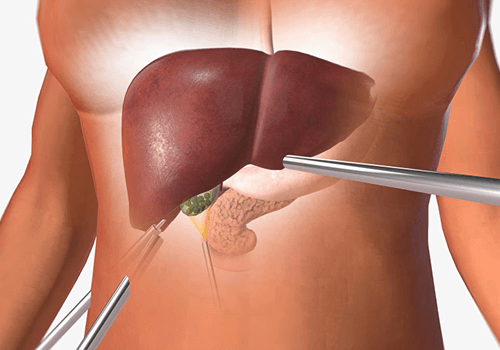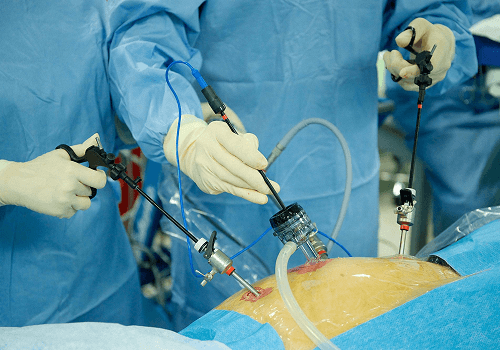
Home / Blog / Understanding Laparoscopic Gallbladder Surgery: Procedure, Recovery, and Benefits
Millions of people globally suffer from , especially gallstones.
These stones may obstruct bile ducts, leading to intense colicky pain, vomiting, nausea, and cholecystitis or cholangitis. In most cases, doctors advise laparoscopic gallbladder surgery. It is a minimal procedure that is considered the best way of treating the condition today.
In this blog, we will discuss the laparoscopic gallbladder removal, its comparison to conventional surgery, recovery, and reasons for considering it for yourself or someone close to you.

The gallbladder is a small organ that lies just below the liver. It keeps bile, which is made by the liver, to aid in fat digestion. Eating fatty food makes the gallbladder squeeze and let out bile into the small intestine.
However, sometimes cholesterol or pigment imbalances in bile can lead to the formation of gallbladder stones. These may obstruct the bile duct, causing pain (biliary colic), inflammation (cholecystitis), and serious complications such as pancreatitis. In such situations, it is important to take out the gallbladder.
The gallbladder is not a vital organ. When it is taken out, bile from the liver goes straight to the small intestine. Many individuals undergo uneventful digestion even after losing their gallbladder.

Laparoscopic gallbladder surgery is a type of keyhole surgery that is done to take out the gallbladder. During this procedure, small cuts are made instead of one large cut, as is done in the conventional open surgery. With these, the surgeon puts in a laparoscope and special surgical tools.
Using this technique, the doctor can see inside the body through a screen and take out the gallbladder without harming other parts too much. Normally, the entire cholecystectomy procedure typically takes 30 to 90 minutes.
Why It’s Preferred Over Open Surgery
The traditional open technique has been overtaken by laparoscopic surgery in popularity for removing the gallbladder because it has several benefits:
This surgery is generally recommended for people who:
Sometimes, doctors may advise patients to attempt other methods of treatment, such as changing their eating habits or taking some drugs, all of which are only able to make the situation better for a short time. If gallstones continue to cause problems, gallbladder surgery becomes the most effective long-term solution.

Knowing what usually occurs during a cholecystectomy can reduce preoperative distress. The usual process is as follows:
You will have your blood taken and an ultrasound or CT scan to see how your gallbladder is. You will also need to abstain from eating for a minimum of six to eight hours before the operation.
The process is done with general anaesthesia for enhanced safety and comfort.
The surgeon makes 3 to 4 small incisions (about 5–10 mm each) in your abdomen.
A small hole is made in the body, and a laparoscope with a powerful camera is put through it to show pictures of the inside of the belly on a screen.
The surgeon is given additional space to operate by slightly inflating the abdomen with carbon dioxide gas.
The surgeon uses special tools that are put through the other incisions. The surgeon clips and clips the cystic duct and artery, separates the gallbladder, and takes it out via any of the cuts while being cautious enough.
After taking out the tools, the little cuts are stitched up, taped, or sealed. Bandages are put on every spot.
Afterwards, the individual is transferred to the recovery area, where the patient’s condition will be observed for some time.
The recovery process is usually smooth and rapid for most patients.
Hospital Stay
Patients are usually released from the hospital after they are monitored for some time after surgery.
First 48 Hours
Weeks 1–2
Weeks 3–4
A few individuals may have mild diarrhoea, gas, or bloating. Such symptoms are referred to as post-cholecystectomy syndrome, and they normally go away after some time. Certain lifestyle changes may be recommended for a normal life after gallbladder removal.
Laparoscopic removal offers a wide range of benefits:
People who have gallstones or an inflamed gallbladder can be safely, quickly, and completely treated with laparoscopic gallbladder surgery. This keyhole surgery for gallstones ensures that patients get back on their feet very fast with little pain but a great prognosis for many years.
If you have gallbladder problems such as pain, indigestion, or stones, and you are thinking about a laparoscopic cholecystectomy, then talk to your doctor. The surgery is simple today due to medical progress; it gives great results, and there are few complications in most cases.
By understanding the cholecystectomy procedure, recovery expectations, and associated benefits, you can make an informed decision and take proactive steps toward better digestive health and an improved quality of life.